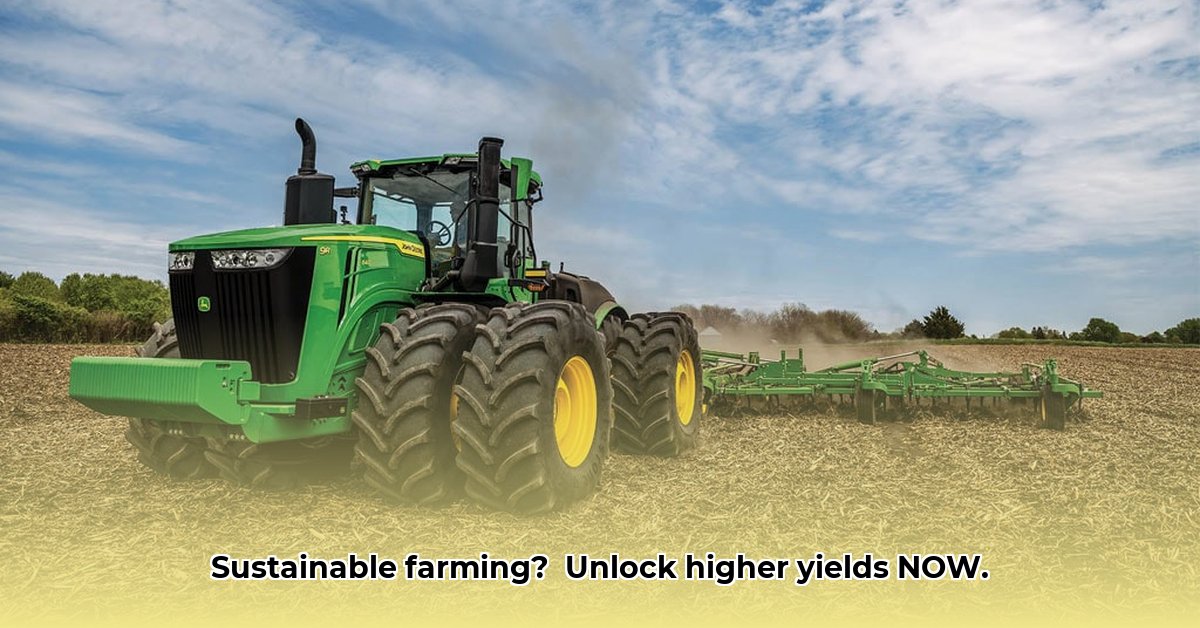
John Deere 4WD Tractors: A Giant Leap for Sustainable Farming?
The agricultural landscape is evolving rapidly, demanding increased efficiency and sustainability. John Deere's 4WD tractors, boasting horsepower exceeding 600 (and even reaching 830 in some configurations), represent a significant technological advancement. But are these powerful machines truly the key to unlocking sustainable farming practices, or is there a more nuanced story? This analysis explores the multifaceted impact of these tractors, weighing their benefits against potential drawbacks. For more information on choosing the right tractor, check out this helpful resource: best tractors for hay farming.
The Allure of Power and Increased Yields
Larger farms necessitate machinery capable of covering vast areas quickly and efficiently. John Deere 4WD tractors answer this need, offering significantly faster fieldwork and the potential for substantially higher yields. This is particularly crucial as climate change shrinks harvest windows, increasing the pressure to maximize output in shorter periods. However, the question remains: does the increased efficiency outweigh the environmental consequences of operating such powerful machines?
High-Tech Farming: Precision and Resource Optimization
Modern John Deere 4WD tractors are more than just powerful engines; they are sophisticated technological platforms integrating precision agriculture tools. GPS guidance systems automate steering, ensuring perfectly straight rows and minimizing overlaps, while soil sensors provide real-time data on conditions, optimizing fertilizer and water usage. This precision significantly reduces resource waste and maximizes crop production. But, does the technological advantage completely offset the environmental footprint of these high-powered machines? Are the gains in efficiency sufficient to counterbalance increased fuel consumption?
The Sustainability Imperative: A Comprehensive Assessment
While these tractors promise increased efficiency and higher yields, potentially leading to lower per-unit production costs, a critical examination of their environmental impact is imperative. Fuel consumption is a major concern. Do the yield increases genuinely outweigh the increased greenhouse gas emissions resulting from higher fuel usage? Comprehensive, long-term studies encompassing the entire life cycle of these tractors – from manufacturing to disposal – are essential for a complete understanding of their environmental impact. Full transparency from manufacturers regarding this data is paramount.
The Small Farm Challenge: Access and Economic Equity
The focus on high-horsepower machines raises crucial questions about affordability and access. Smaller farms, often champions of sustainable practices, may lack the financial resources to acquire these powerful tractors. This creates a significant economic disparity, exacerbating existing inequalities within the agricultural sector. Addressing this requires innovative solutions, such as equipment-sharing cooperatives or rental programs, to foster collaboration and equitable resource distribution. How can we support smaller, often more environmentally conscious farms while acknowledging the needs of large-scale operations?
A Balanced Perspective: Advantages and Disadvantages
The following table summarizes the key advantages and disadvantages of utilizing John Deere 4WD tractors:
| Feature | Pros | Cons |
|---|---|---|
| Power & Efficiency | Significantly faster fieldwork; potential for higher yields | High fuel consumption; potentially substantial carbon footprint; increased operational costs |
| Precision Agriculture | Optimized resource use; reduced waste; improved yields | High initial investment; complex technology; dependence on robust technology infrastructure |
| Economic Impact | Improved profitability for large-scale operations; increased food production | High barrier to entry for smaller farms; potential for economic disparity within the agricultural sector |
| Environmental Impact | Potential for reduced environmental impact if used responsibly | Significant fuel consumption; potential increase in greenhouse gas emissions; disposal challenges |
How to Minimize Fuel Consumption in Large John Deere Tractors
Key Takeaways:
- Fuel efficiency is paramount: Both for economic profitability and environmental stewardship.
- Ballasting is critical: Proper weight distribution minimizes wasted fuel.
- Operational practices matter: Reducing idle time and maintaining consistent speeds are essential.
- Precision agriculture technologies: These are indispensable tools for optimizing fuel efficiency.
- Data-driven decision-making: Continuous monitoring is vital for optimizing fuel use.
Optimizing Ballasting for Fuel Efficiency
Improper ballasting negatively impacts fuel consumption. Accurate weight distribution is crucial for optimal traction and fuel efficiency. John Deere provides ballasting guidelines for specific models, but real-world conditions require adaptation. Utilize digital tools to optimize weight distribution based on field conditions and regularly assess and adjust your strategy. Don't underestimate the impact of proper ballasting.
Leveraging Precision Agriculture for Fuel Savings
Precision farming techniques like GPS-guided steering minimize overlaps, reducing wasted time and fuel. Variable rate application allows for precise input application, further optimizing resource use. Investment in these technologies offers long-term returns through fuel savings. The extent of the savings depends on various factors, but studies consistently demonstrate significant fuel economy improvements.
Operational Best Practices: Simple Steps, Significant Savings
Minimizing idle time through effective work planning and utilizing auto-shutdown features significantly reduces fuel consumption. Maintaining consistent speeds and RPMs, avoiding sudden accelerations, and understanding optimal RPMs for specific tasks contribute to smoother, more fuel-efficient operations. Think of smooth driving as the key to fuel saving.
Tire Pressure: A Frequently Overlooked Factor
Proper tire pressure directly impacts fuel efficiency. Under-inflation increases rolling resistance, while over-inflation stresses tires and shortens their lifespan. Adhere to John Deere's tire pressure recommendations for varying terrains and operational conditions. Regular checks are essential due to fluctuating conditions.
Continuous Monitoring and Data Analysis: Fuel Efficiency Trackers
Track fuel usage across various tasks and conditions to identify areas for improvement. This data-driven approach enables ongoing optimization and highlights potential mechanical issues that might be contributing to higher-than-expected fuel consumption. A well-maintained tractor uses fuel more efficiently.
Long-Term Strategies for Enhanced Fuel Efficiency
Explore alternative fuels like biodiesel, considering their economic and environmental consequences within your operational context. Advocate for transparency in manufacturer-provided fuel consumption data and support research into fuel-efficient technologies and sustainable agricultural practices. The path to sustainable farming requires collective effort and ongoing innovation.